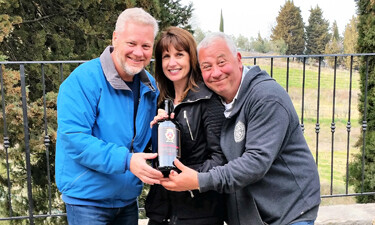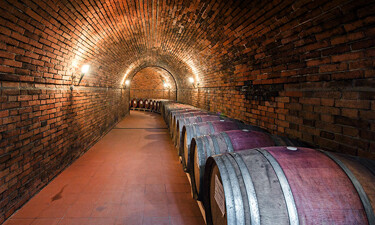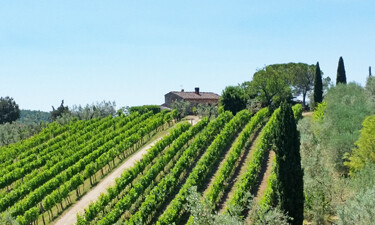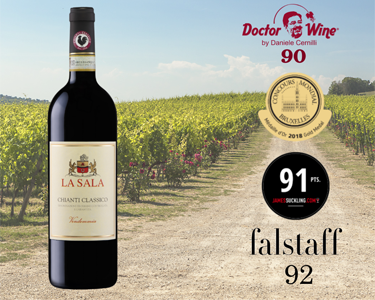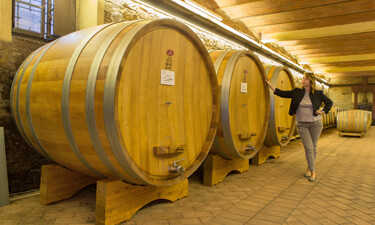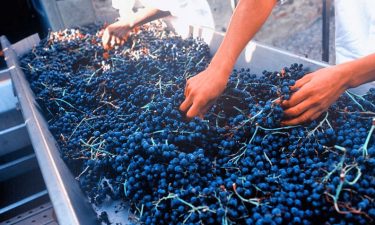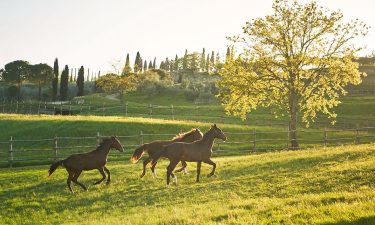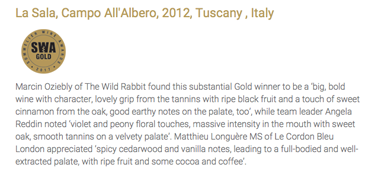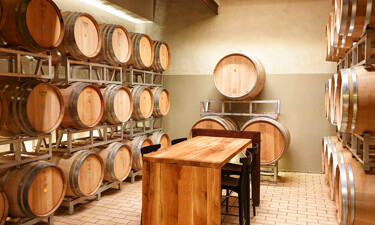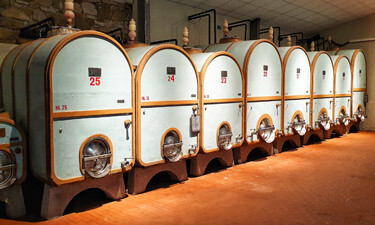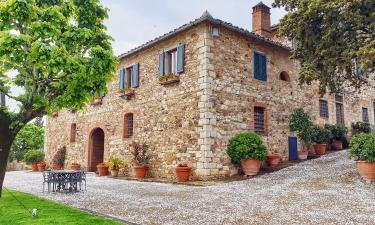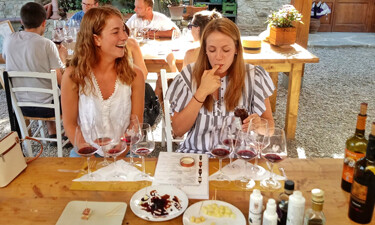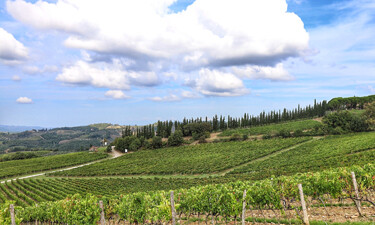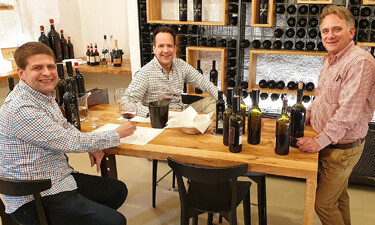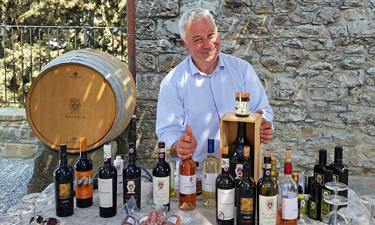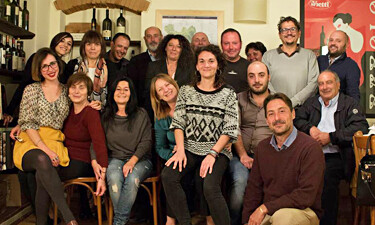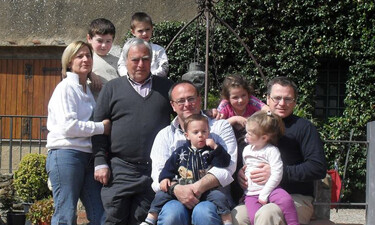My favorite Tuscan wineries
The Tuscan wineries I visit on my tours are family estates, some of medium size, while others are very small indeed. I often get asked how I choose them…the answer is simple. I choose wineries where the quality of the wines, and the quality of the welcome go hand in hand. Each aspect is equally important, and not all wineries have a combination of the two. I’ve visited many estates over the years, and I’ve narrowed it down to a small handful who satisfy my requirements to the full. I’m not concerned with how famous they are, in fact I avoid the big names. Visits last from one to one and half hours, and we take in two estates. We also take a leisurely drive through the iconic Tuscan scenery and I’ll give you ample time for photos. I assure you of a representative experience of both Chianti and Super Tuscan wines.
Maurizio Brogioni
Maurizio Brogioni is one of the smallest Tuscan wineries of the Chianti region, and everything you’d expect of a family estate. It’s run by Maurizio and his wife Cristina, who’s family have been producing wine for generations. The current property of 10 acres was acquired by Maurizio’s father in the 1950’s. At that time farming was pretty much 360 degrees and they sold vegetables, pigs, chickens, olive oil and wine. Then things changed during the seventies, and traditional all round farming was replaced everywhere in the Chianti region with “just” olive oil and wine. Maurizio took on the business from his father in 1990. The tastings here are always enjoyed by everyone, firstly because of Maurizio’s jovial character, and secondly, but by no means least, the excellence of the wines he produces.
The annual production is only 12000 bottles a year between Chianti, Chianti Reserve, and a Super Tuscan based on Merlot and Syrah. Maurizio only uses his own estate grown (organic) grapes, and though he could buy grapes to increase his very limited production, he doesn’t trust other growers. He prefers to produce less, but produce well. His motto is “to make good wine your need good grapes.” As an added bonus, the olive oil from his centuries old orchard is something to write home about too. Your visit here will be totally private, and you’ll have the pleasure of meeting Maurizio in person who always finds a way of charming my guests with his disarming personality.
Monterinaldi
Many Tuscan wineries take their name from ancient castles, and this is the case of Monterinaldi. The castle stood perched on the nearby hill till 1268 when it was destroyed by the Sienese. It subsequently became a tiny but lovely hamlet. The farming activities located below the hill at Pesanella has always been part of the property, and was acquired by the Ciampi family in 1961, and it’s now run by Daniele Ciampi who is second generation. As all of my wineries, it’s a family estate albeit one the larger and more influential. Monterinaldi has eighteen single Vineyards spread over 136,000 acres. The grapes grown are Sangiovese, Petit Verdot, Syrah, Gamay, Merlot, Cabernet-Sauvignon, Cabernet-Franc, and other native Tuscan varietals. After a four year experimental period, organic management has been extended to the entire property and is certified as of the 2017 vintage.
The whole wine making process takes place on the estate, using only estate grown grapes. The Tradition of Tuscan wine making methods is a fundamental principle at Monterinaldi, and their primary goal is to offer Chianti Classico in its most traditional form, however taking advantage of all the recent technology possible. Their other claim to fame is a superb Super Tuscan. The ancient underground cellars make the perfect environment for aging wine. Here their Chianti Classico is first kept in barrels (french oak tonneaux and barriques) and then refined in bottles, for periods ranging from 6 months to 2 years. Last but certainly not least they have one of the happiest staff in the whole region which is why Monterinaldi is a favorite stop of my Wine Lover’s Tour. They are always eager to make your visit a memorable one; and all my guests over the years have confirmed this last statement.
Tenuta Degli Dei
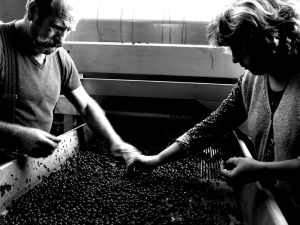
Just one example: after hand-picking, the grapes are placed on a conveyor belt where a two stage selection process is carried out. One for the clusters and one for the berries. Only the best examples continue the process, while all the rest become compost.
The results are now coming in, with numerous recognitions in the press. Above all, I value the praise from my guests who I take there on a regular basis.
Casa Emma

HANDWORK AND HARVEST
To preserve the vines and guarantee excellent fruits, almost all the operations in the vineyards are carried out manually. Manual picking remains the tradition at Casa Emma. The grape harvest is a very important moment for the winery and completes the work done in the vineyards throughout the whole year. It is not just harvesting; it’s is the selection done strictly by hand of the best grape clusters that will ensure a high-quality level of wine.
ORGANIC FARMING
Casa Emma follows biodynamic and organic viticulture principles. The vineyards are treated with natural methods, without using pesticides or phytosanitary products. Only natural composts are used all of which are produced 0n the farm.
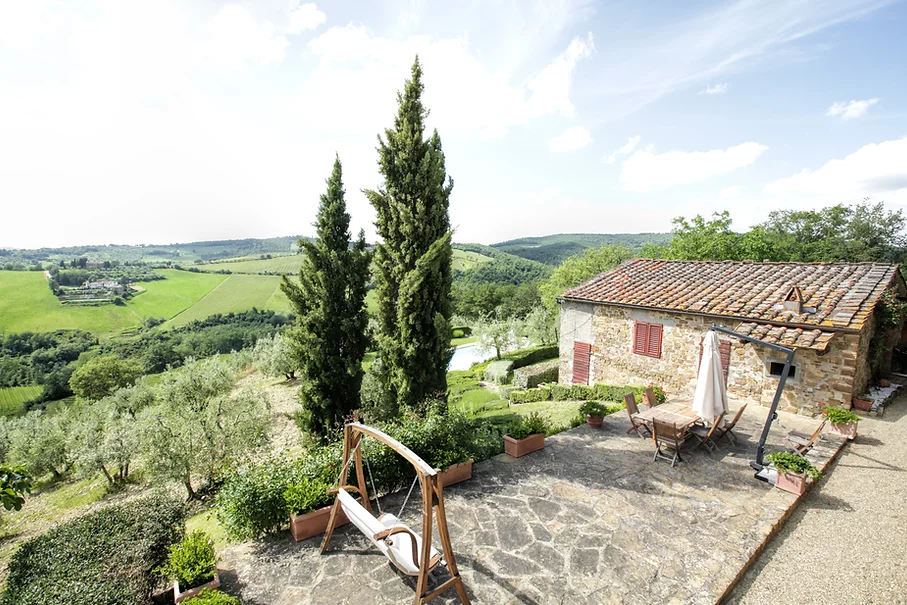
The vines are cultivated according to the most advanced viticultural trends, meaning high density vineyards and a minimal number of clusters per plant. Harvesting is strictly manual in order to prevent damage to the grapes before they reach the cellars, and also permit the pre selection of the best clusters for the top wines.
Once in the cellars the must ferments at controlled temperature with long maceration periods, and all is carried out with meticulous attention to detail. This allows the creation of fresh wines of great olfactory richness, but counterbalanced with structure and power.
Ageing is carried out in Slavonian oak barrels for Chianti, and French oak barriques for the Super Tuscans. The excellence of Carobbio wines is the result of a rigorous project, in which each vineyard has a specific role, each step is the subject of meticulous care, and every action is a precise choice.
Castellinuzza e Piuca
From the middle ages, farming on Tuscan wineries was done by share croppers who always got a very bad deal from the land owners. For this reason the system was made illegal in the 1960’s. This period also coincided with Italy’s economic and industrial boom, so farmers where leaving the countryside to get jobs in factories. This left the farms unattended. For these reasons the land owners got rid of their properties and would do so at very low prices. Though they were quite poor, the advantageous prices meant some of the estates were acquired by the farmers themselves. The result is that today they are run by their sons and grandchildren. This is the case of Castellinuzza and Piuca. The tiny family winery is run by Simone and Francesco , who’s father originally bought the property in 1961.
With pride and passion they produce wine “as the weather permits.” This means a lot of tradition with just a hint of modern technology. They insist on saying “our wines are made with sunshine and rain,” and consequently will be different every year. Unlike the big corporations who produce standardized wines time after time, no matter what. One should ask how do they do that…is it all grape juice? As often happens with the smaller Tuscan wineries, the vineyards at Castellinuzza are cut out of the hills on Terraces. This makes viticulture very difficult, but the scenery for visitors is a true feast for the eyes. I often visit this winery at midday for a genuine home cooked lunch. The meals are prepared by the ladies of the house and of course we’ll be tasting their excellent Chianti wines and genuine olive oil.
Azienda Agricola Altiero
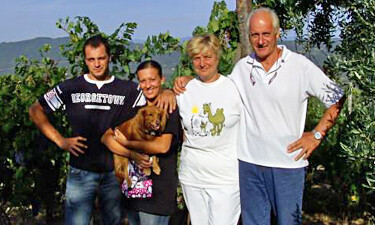
They’ve come a long way since the garage days, and now have modern high tech cellars where they produce outstanding Chianti, Chianti Classico, a Super Tuscan and a Rosè. The emphasis is on traditional Tuscan wines, which means fruit and a bright acidity which lends them to be consumed with hearty food. In fact this is one of the wineries of my Tuscan Family Winery and Home Cooked Lunch Tour where you will find out just how good Chianti can be with the right food. The meals are prepared by Samuela, who though not a chef never ceases to amaze my guests with her cooking. Many state it’s the best meal of their holiday, and you can believe them. Last but not least they produce some of the best olive oil you can find.
La Sala
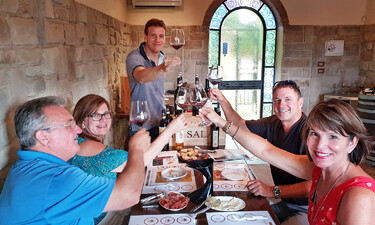
The basis of what the estate is today was established by Laura Baronti who owned it from 1981 to 2014. Together with her oenologist (wine maker) Gabriella Tani, she built a solid reputation for the excellence of their Chainti Classico wines. Particular prestige has always been associated with their supertuscan ” Campo all’Albero” which is a 50/50 blend of Cabernet & Merlot. It’s still produced today, and it’s as good as ever without the exaggerated prices of some of the more famous supertuscans.
Franceso Rossi Ferrini who was already the owner of another the prestigious estate called il Torriano, acquired La Sala in 2014. He immediately implemented a modernization program both in the vineyards and the cellars. The estate is now fully organic with sustainable farming which respects bio diversity.
The estate has vineyards with altitudes that vary between 500 & 1150 feet, and varying exposition to the sun. This means varying grades of ripeness, and the possibility of harvesting depending on requirements for a given season. The estate covers a total of 173 acres, of which only 79 are dedicated to vineyards.
By the way. All Chianti wines are dependent on, and made by the weather. There’s no irrigation in the field, and “manufacturing” practices in the cellar which may be common in many parts of the world, but here are limited and even illegal. Of course modern wine making processes have reached a fine degree of perfection, and it’s possible to make an acceptable product even in the not so good seasons. If it’s a very bad season Chianti isn’t made, but fortunately this happens rarely and the last ten years have given good to outstanding wines. The point is; they are different every year, as opposed to always being the same no matter what the weather. I suggest you be wary of what you’re drinking with standardized wines.
Caparzo
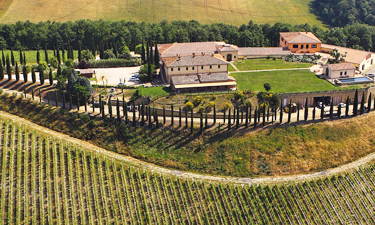
The estate went through extensive renovation of the buildings and the planting of new vineyards. In a short time, Caparzo was able to impose itself on the market of Brunello. Thirty years later passed then in 1998, the estate came to a turning point when Elisabetta Gnudi Angelini purchased Caparzo.
She immediately carried out her objectives of combining tradition with innovation to create some the highest quality wines coming out of the appellation. Wines that have been highly praised both abroad and at home by the press, but more importantly by the local sommeliers associations.
The vines are trained with the spurred cordon system, with an average density of 5,000 plants per hectare. The vineyards are carefully looked after during the whole growth cycle, and nothing is left to chance. The grapes are field-selected before the harvest, which is done entirely by hand in order to check only pick flawless clusters.
Harvesting starts with white grapes for the production of “Le Grance” at the beginning of September, and continues with red grapes in the third week and ends mid October. The last grape to be harvested is the white muscat, that Caparzo interprets with late-vintage Moscadello di Montalcino d.o.c., in a very limited number of bottles.
